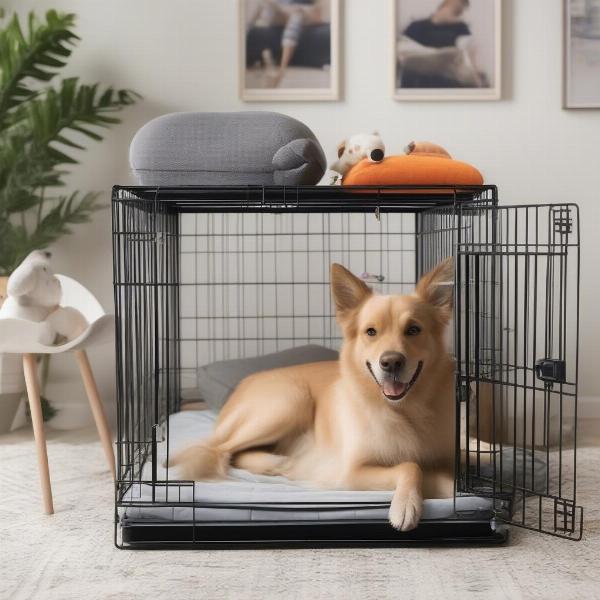A lockable dog cage can be a valuable tool for dog owners, providing a safe and secure space for your furry friend. Whether you’re using it for crate training, transportation, or managing your dog’s behavior, a lockable cage offers peace of mind. Choosing the right one involves considering your dog’s size, breed, and temperament, as well as the cage’s features, durability, and portability. This comprehensive guide will delve into the world of lockable dog cages, helping you make an informed decision that prioritizes your dog’s well-being.
Choosing the Right Lockable Dog Cage
Selecting the appropriate lockable dog cage is crucial for your dog’s comfort and safety. Consider the following factors when making your choice:
- Size: Your dog should be able to stand, turn around, and lie down comfortably in the cage.
- Material: Metal cages are durable and easy to clean, while plastic ones are lighter and more portable.
- Lock mechanism: Ensure the lock is secure and easy to operate.
- Ventilation: Good airflow is essential for your dog’s comfort, especially in warmer climates.
- Portability: Consider whether you need a foldable or collapsible cage for easy transport and storage.
Benefits of Using a Lockable Dog Cage
Lockable dog cages offer numerous advantages for both dogs and owners:
- Safety: They prevent dogs from getting into trouble or injuring themselves when unsupervised.
- Security: They provide a secure den-like space where dogs can feel safe and comfortable.
- House training: Crates can be invaluable tools for potty training puppies.
- Travel: They make transporting dogs safer and easier, whether by car or plane.
- Behavior management: They can help manage destructive behaviors or anxiety.
Addressing Common Concerns About Lockable Dog Cages
Some dog owners hesitate to use cages, fearing they are cruel or confining. However, when used correctly, lockable dog cages can be a positive and enriching part of a dog’s life.
- Is it cruel to crate a dog? No, when used properly, a crate provides a safe haven, not a prison. It’s important to introduce the crate gradually and positively, associating it with positive experiences like treats and toys. Never use the crate as punishment.
- How long can a dog stay in a lockable cage? Adult dogs should not be crated for more than 6-8 hours at a time, while puppies require more frequent breaks.
- Will my dog become anxious in a cage? Proper introduction and positive reinforcement can prevent cage anxiety. Ensure the cage is a comfortable and inviting space.
 Addressing concerns about lockable dog cages
Addressing concerns about lockable dog cages
Maintaining and Cleaning Your Lockable Dog Cage
Regular cleaning is essential to maintain hygiene and prevent the spread of bacteria.
- Remove bedding and toys: Wash bedding regularly and replace worn toys.
- Wipe down surfaces: Use a pet-safe disinfectant to clean the cage walls and floor.
- Rinse thoroughly: Ensure all traces of disinfectant are removed before allowing your dog back in.
Tips for Crate Training Your Dog
Crate training requires patience and consistency. Start by introducing your dog to the crate gradually, making it a positive experience.
- Start slow: Encourage your dog to explore the crate on their own terms.
- Positive reinforcement: Reward your dog with treats and praise for entering the crate.
- Mealtime in the crate: Feed your dog their meals in the crate to create a positive association.
- Never force your dog into the crate: This can create negative associations and make crate training more difficult.
Conclusion
A lockable dog cage can be a valuable asset for dog owners, offering safety, security, and peace of mind. Choosing the right cage, using it correctly, and maintaining it properly are essential for ensuring your dog’s comfort and well-being. By following the guidelines outlined in this article, you can make the most of a lockable dog cage and create a positive experience for your canine companion.
FAQ
- What is the best material for a lockable dog cage? Both metal and plastic have their advantages. Metal is more durable, while plastic is lighter and more portable. The best choice depends on your individual needs.
- Can I use a lockable dog cage for air travel? Yes, but you’ll need an airline-approved crate that meets specific size and ventilation requirements.
- How do I prevent my dog from barking in their crate? Ensure your dog is comfortable and not anxious. Provide toys and chews to keep them occupied. Ignore barking initially, and reward quiet behavior.
- What size crate should I get for my puppy? Choose a crate that allows your puppy to stand, turn around, and lie down comfortably, but not so large that they can eliminate in one corner and sleep in another.
- Can I leave my dog in a crate overnight? Yes, for adult dogs. Puppies will need more frequent potty breaks.
- How do I clean a lockable dog cage? Remove bedding and toys, wipe down the surfaces with a pet-safe disinfectant, and rinse thoroughly.
- Is it okay to cover a dog crate? Some dogs find a covered crate more den-like and secure, while others prefer an open view. Observe your dog’s preference.
Related Articles on ILM Dog
ILM Dog is your trusted source for expert advice on all aspects of dog care. From breed selection and health to training, nutrition, and grooming, we offer comprehensive and practical information to help you provide the best possible care for your furry friend. We also offer a wide range of carefully selected products and accessories to support your dog’s well-being. For any questions or inquiries, please contact us at [email protected] or call us at +44 20-3965-8624. Visit ILM Dog today!